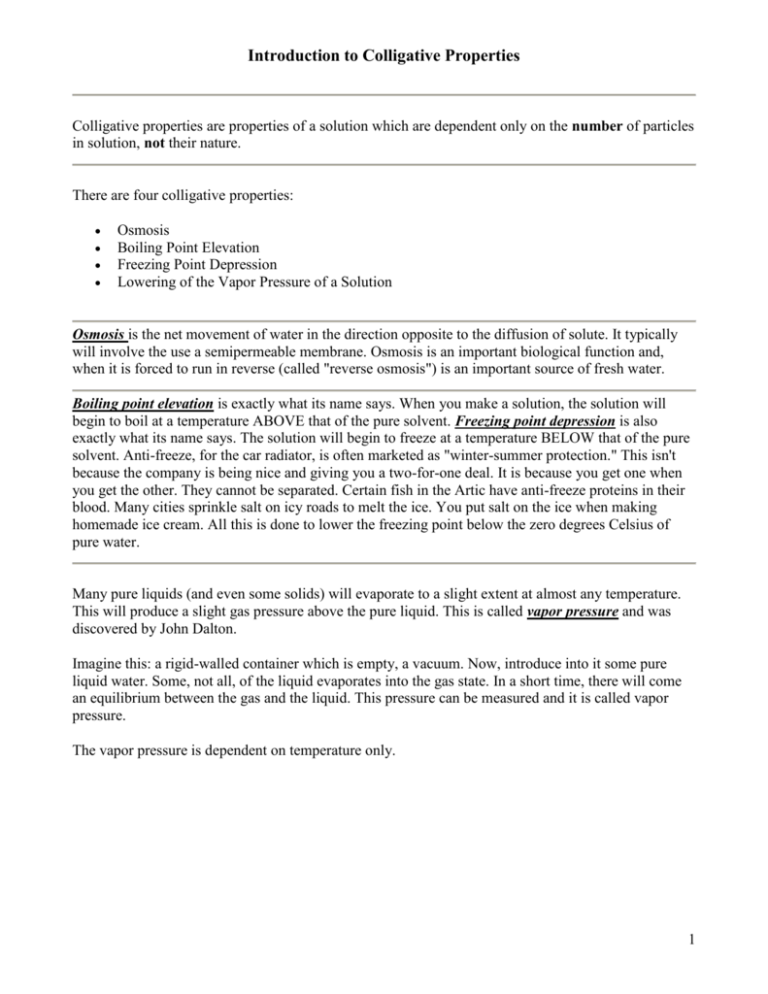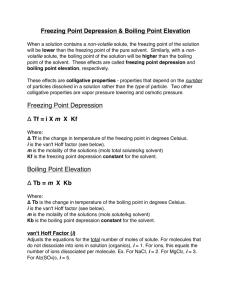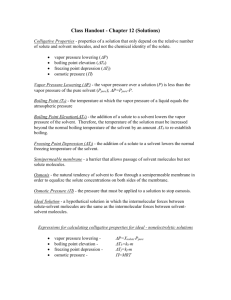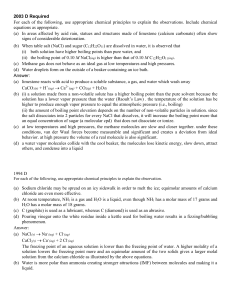Introduction to Colligative Properties
advertisement

Introduction to Colligative Properties Colligative properties are properties of a solution which are dependent only on the number of particles in solution, not their nature. There are four colligative properties: Osmosis Boiling Point Elevation Freezing Point Depression Lowering of the Vapor Pressure of a Solution Osmosis is the net movement of water in the direction opposite to the diffusion of solute. It typically will involve the use a semipermeable membrane. Osmosis is an important biological function and, when it is forced to run in reverse (called "reverse osmosis") is an important source of fresh water. Boiling point elevation is exactly what its name says. When you make a solution, the solution will begin to boil at a temperature ABOVE that of the pure solvent. Freezing point depression is also exactly what its name says. The solution will begin to freeze at a temperature BELOW that of the pure solvent. Anti-freeze, for the car radiator, is often marketed as "winter-summer protection." This isn't because the company is being nice and giving you a two-for-one deal. It is because you get one when you get the other. They cannot be separated. Certain fish in the Artic have anti-freeze proteins in their blood. Many cities sprinkle salt on icy roads to melt the ice. You put salt on the ice when making homemade ice cream. All this is done to lower the freezing point below the zero degrees Celsius of pure water. Many pure liquids (and even some solids) will evaporate to a slight extent at almost any temperature. This will produce a slight gas pressure above the pure liquid. This is called vapor pressure and was discovered by John Dalton. Imagine this: a rigid-walled container which is empty, a vacuum. Now, introduce into it some pure liquid water. Some, not all, of the liquid evaporates into the gas state. In a short time, there will come an equilibrium between the gas and the liquid. This pressure can be measured and it is called vapor pressure. The vapor pressure is dependent on temperature only. 1 Boiling Point Elevation A solution will boil at a higher temperature than the pure solvent. This is the colligative property called boiling point elevation. The more solute dissolved, the greater the effect. An equation has been developed for this behavior. It is: ΔT = i Kb m Kb is the boiling point depression constant. m is molality (moles per kilogram) These are some sample ebullioscopic (Kb) constants: Substance Kb benzene 2.53 camphor 5.95 carbon tetrachloride 5.03 ethyl ether 2.02 water 0.52 The units on the constant are degrees Celsius per molal (°C m¯1). There are some variations on the theme you should also know: 1) K m¯1 - the distance between a single Celsius degree and a Kelvin are the same. 2) °C kg mol¯1 - this one takes molal (mol/kg) and brings the kg (which is in the denominator of the denominator) and brings it to the numerator. . The van 't Hoff Factor The van 't Hoff factor is symbolized by the lower-case letter i. It is a unitless constant directly associated with the degree of dissociation of the solute in the solvent. Substances which do not ionize (they would be molecular or covalently bonded) in solution, like sugar, have i = 1. Substances which ionize into two ions, like NaCl, have i = 2. Substances which ionize into three ions, like MgCl2, have i = 3. And so on. . . . 2 Freezing Point Depression A solution will solidfy (freeze) at a lower temperature than the pure solvent. This is the colligative property called freezing point depression. The more solute dissolved, the greater the effect. An equation has been developed for this behavior. It is: ΔT = i Kf m Kf is the freezing point depression constant. These are some sample cryoscopic constants: Substance Kf benzene 5.12 camphor 40. carbon tetrachloride 30. ethyl ether 1.79 water 1.86 The units discussion pertaining to Kb applies to Kf also. Information regarding “i” is the same. An Important Point About the Boiling Point and Freezing Point of a Solution Pure substances have true boiling points and freezing points, but solutions do not. For example, pure water has a boiling point of 100 °C and a freezing point of 0 °C. In boiling for example, as pure water vapor leaves the liquid, only pure water is left behind. Not so with a solution. As a solution boils, if the solute is non-volatile, then only pure solvent enters the vapor phase. The solute stays behind (this is the meaning of non-volatile). However, the consequence is that the solution becomes more concentrated, hence its boiling point increases. If you were to plot the temperature change of a pure substance boiling versus time, the line would stay flat. With a solution, the line would tend to drift upward as the solution became more concentrated. This is why you put salt in water when you are cooking. Salt in water is an example of a non-volatile solute. Only water will boil away and, when dry, a white solid (the NaCl) remains. It actually raised the boiling point so your food will cook at a higher temperature thus cooking it faster! 3 A non-volatile solute is one which stays in solution. The vapor that boils away is the pure solvent only. A volatile solute, on the other hand, boils away with the solvent. Hexane dissolved in pentane is an example of a volatile solute. The vapor will be a hexane-pentane mixture. Boiling Point Elevation Problems 1) Seawater is about 3.5% (by weight) dissolved solids, almost all of which is NaCl. Calculate the normal boiling point of seawater. Solution A bit of analysis. Some comments prior to starting: a) 3.5% means 3.5 grams of solids per 100 grams total of solution. So that means 3.5 grams of solids are dissolved in 96.5 grams of water. c) since we know most of the solids are NaCl, we can't go too wrong is we assume NaCl is 100%. Some error is introduced, but not too much. a) Calculate moles of NaCl: 3.5 g / 58.5 g mol¯1 = 0.0598 mol b) Calculate molality of NaCl: m = 0.0598 mol / 0.0965 kg = 0.612 m c) use boiling point elevation constant: ΔT = i Kb m x = (2) (0.52 °C m¯1 ) (0.612 m) = 0.64 °C So, add that number to the normal boiling point of water and the sea water boils at 100.64 °C . (Remember, we assumed all our salts were NaCl.) Your turn 4 Name ________________________________________Date ________ Block ______ Boiling Point Elevation (Remember to add the number to 100 oC) 1) What is the boiling point of a 1.50 m MgCl2 solution? Solution 2) A solution of 7.50 g of a nonvolatile compound in 22.60 g of water boils at 100.78 oC at 760 mm Hg. What is the molar mass of the solute? Assume that the solute exists as molecules, not ions. Hint: list what you know and first determine the molality…… 5 3) What is the boiling point of each solution? a. 0.50 mol glucose in 1000 g water b. 1.50 mol NaCl in1000g water Freezing Point Depression Problems (Remember to subtract the value from 0 oC) 1) What is the freezing point of a 1.50 m NaCl solution? Solution 6 2) The freezing point of the water is lowered to -.0390 oC when 3.90 g of a nonvolatile molecular solute is dissolved in 475 g of water. Calculate the molar mass of the solute. Solution 3) Determine the freezing points of each 0.20 m aqueous solution. a. K2SO4 b. CsNO3 c. Al(NO3)3 7







